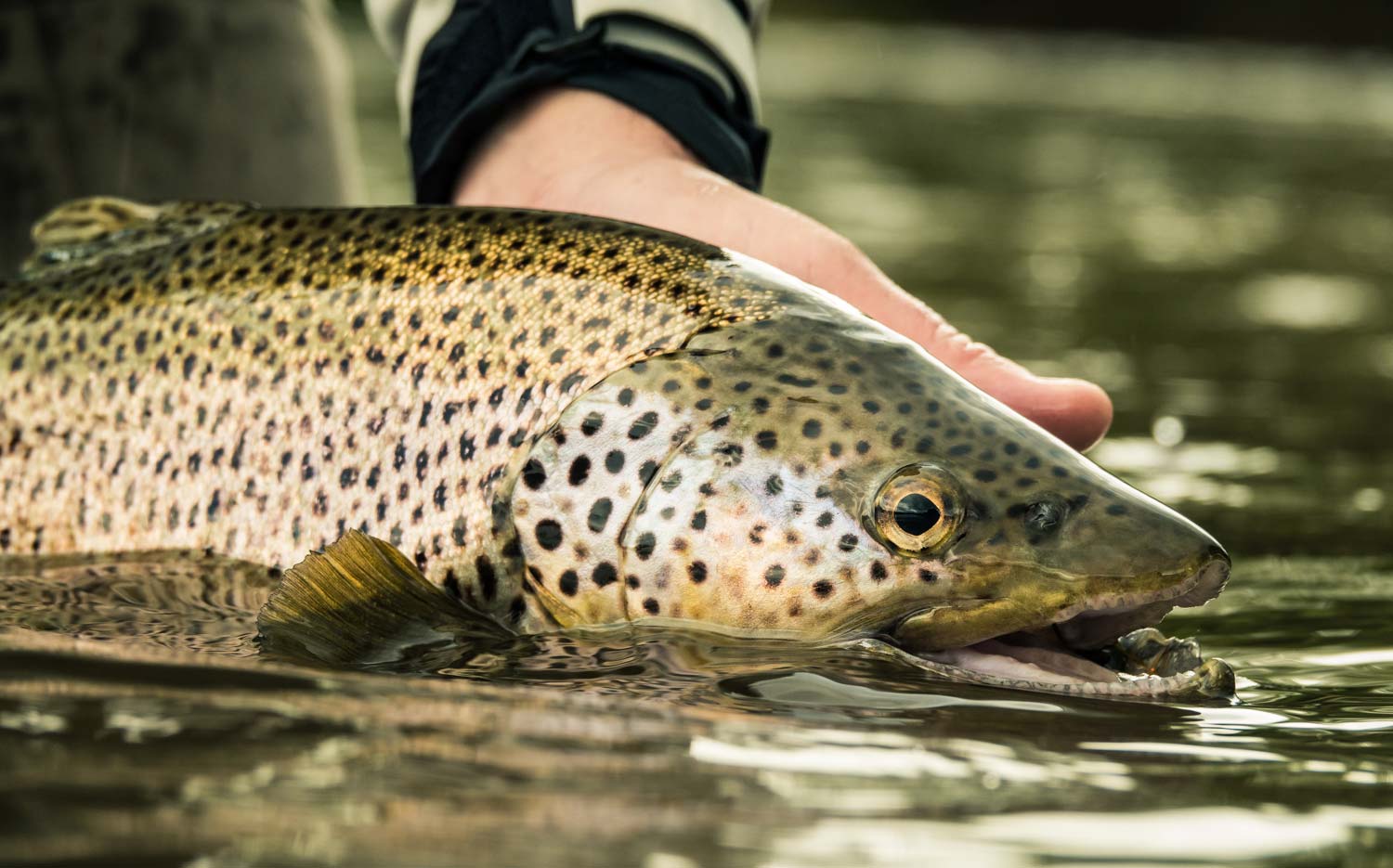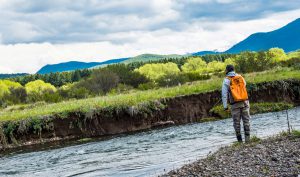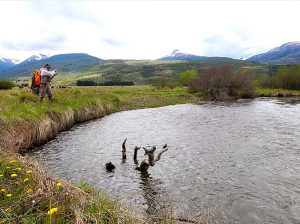
Photo by Louis Cahill
By Louis Cahill
High water events can make it easier to target big fish in unusual places.
Most anglers know from experience that high water often means big fish. There are several reasons for this, not least of which is the confidence mature fish find in the cover offered by higher than usual water. Especially when the water is a little stained, you have the opportunity to target fish who would otherwise only feed at night. In addition to having larger, predatory fish in a feeding mood, high water can also make them easier to find. Especially in smaller streams where high water conditions may make their usual holding water less comfortable.
 On a recent trip to Patagonia, my buddy Johnny Spillane and I fished some unusually high water. Spring, October/November down there, is usually not a wet time of the year, but unexpected heavy rains had rivers swollen and water moving at an unusual tempo. Most of the Patagonian rivers still run crystal clear, even at their highest, but a few showed some color. In spite of the conditions, we had amazing fishing and, though we fished only small streams and rivers, we caught a lot of big fish. In fact, the average size of the fish we caught was larger than I expected.
On a recent trip to Patagonia, my buddy Johnny Spillane and I fished some unusually high water. Spring, October/November down there, is usually not a wet time of the year, but unexpected heavy rains had rivers swollen and water moving at an unusual tempo. Most of the Patagonian rivers still run crystal clear, even at their highest, but a few showed some color. In spite of the conditions, we had amazing fishing and, though we fished only small streams and rivers, we caught a lot of big fish. In fact, the average size of the fish we caught was larger than I expected.
The conditions, and the tactics we employed to fish them, successfully targeted the largest fish in the river.
The first choice made was an obvious one. We passed over the spots where fish would normally hold and fished the margins. The spots that wouldn’t normally offer fish much cover but which, in higher flows, offered soft water where fish could take refuge from the raging current. Many of the spots where we caught quality fish were micro seams created by small structure or nooks where a piece of bank had caved away.
Shallow inside bends were another big producer as are the narrow cushions along steep banks. Tempting looking drop-offs and deep pools under performed and although traditional holding water, like the seams from midstream boulders produced fish, some of the largest fish we caught came from the smaller holds. Many spots produced several nice fish.
The second choice that paid off for us was the decision to fish streamers. That’s not a hard choice for either Johnny or myself. On any given day, in the absence of a clearly productive hatch, we will usually fish streamers. Though we might choose the same flies, Johnny and I have very different styles of fishing them.
I tend to use a more aggressive jerk-strip retrieve to illicit a predatory response, the Kelly Galloup school of streamer fishing. Johnny uses a more subtle approach, dead drifting and twitching his flies with his rod tip high off the water. He fishes a lot of sculpin patterns and has spent a lot of time studying sculpins and how they move in the water. He’s the best I’ve seen at imitating them.
Fishing these small streams on high water Johnny’s method was a clear winner and I was eager to follow his lead.
 To fish this method effectively, forget about your sink-tip lines and unweighted streamers. You need a fly that will sink quickly, a 9 foot or so leader, and a floating line that’s easy to hold above the water. You’re making short casts and fishing in close, so stealth is important. You are frequently moving the fly with or gently across the current, with subtle twitches rather than strips. The take can be vicious or it can be subtle. You have to be on your toes.
To fish this method effectively, forget about your sink-tip lines and unweighted streamers. You need a fly that will sink quickly, a 9 foot or so leader, and a floating line that’s easy to hold above the water. You’re making short casts and fishing in close, so stealth is important. You are frequently moving the fly with or gently across the current, with subtle twitches rather than strips. The take can be vicious or it can be subtle. You have to be on your toes.
As we were often fishing the far bank, directly across from us, we did a lot of roll casting and single hand spey. Johnny’s deep bending Winston rod and SA Infinity line, with its longer belly, was very effective at turning over the bid weighted flies accurately with both casts.
Most of the flies we fished were in the four inch range. Smaller and larger patterns still produced well but four inch articulated streamers were the most consistent. The Rusty Trombone was a favorite, as were tan sculpin patterns. Most of the fish we caught were brown trout thick, with shoulders even in early spring. Where we could sight fish, we targeted browns exclusively as we were there just after the rainbow spawn and there were still a few pairs active.
Next time you’re faced with a high water event, pay some attention to the smaller streams and rivers. Fish the margins with streamers, taking your time and being stealthy. Many small streams hold a few surprisingly large fish and the conditions may work in your favor if you know how to target them.
Good luck!
Louis Cahill Gink & Gasoline www.ginkandgasoline.com hookups@ginkandgasoline.com Sign Up For Our Weekly Newsletter!
Thanks, great advice.
Skinny bank water is not only slower and less turbulent under higher and more turbid flows, but the surface water is also the first to clear as sediments settle from top to bottom. Remember, if fish didn’t feed in high, off-color flows they would be extinct.
G,Day Louis; I thoroughly enjoyed your submission on fishing Patagonia waters for the big Trout..The territory there is certainly very inviting, and the conditions look pristine.
Unfortunately here in Australia, we are experiencing drought like conditions;the
Dams are low, and the water is murky in some areas with lots of weed about.
We are hoping for conditions go improve.
Keep your passion for fishing alive,and look forward to visiting your site down the track…Kind Regards, Big Al,……zeccentrichooker.com